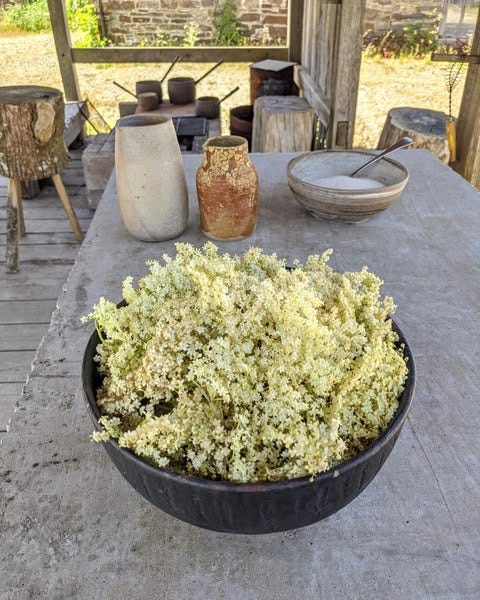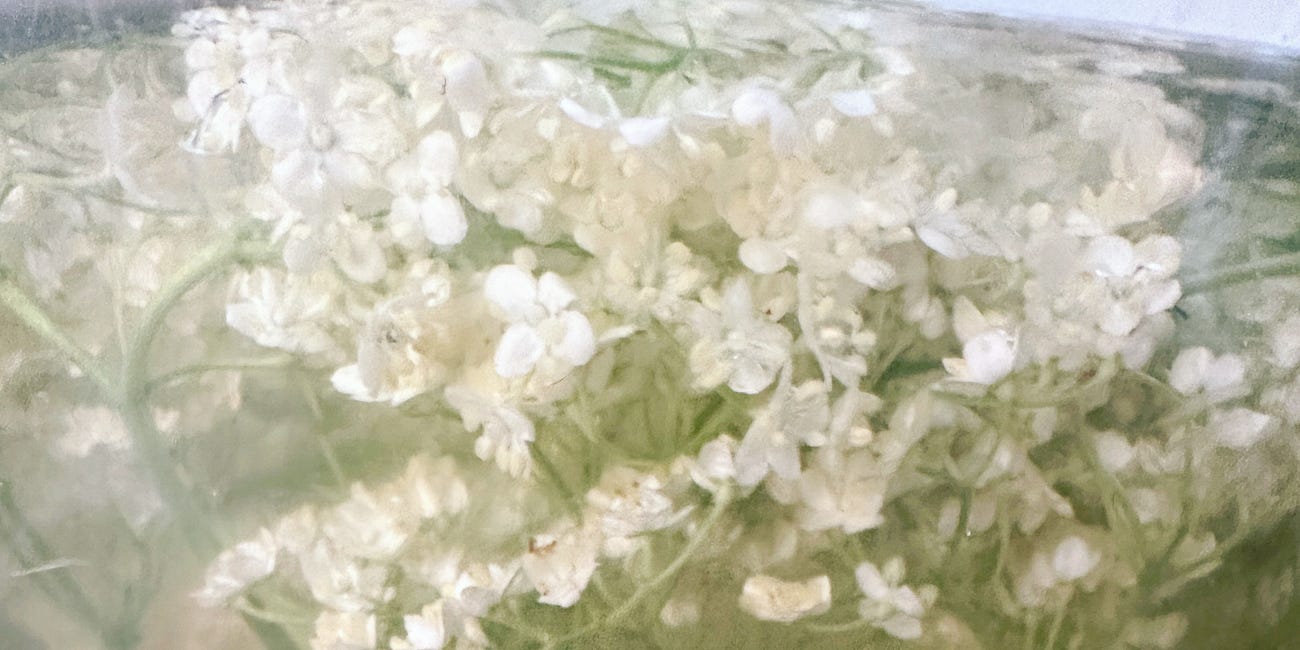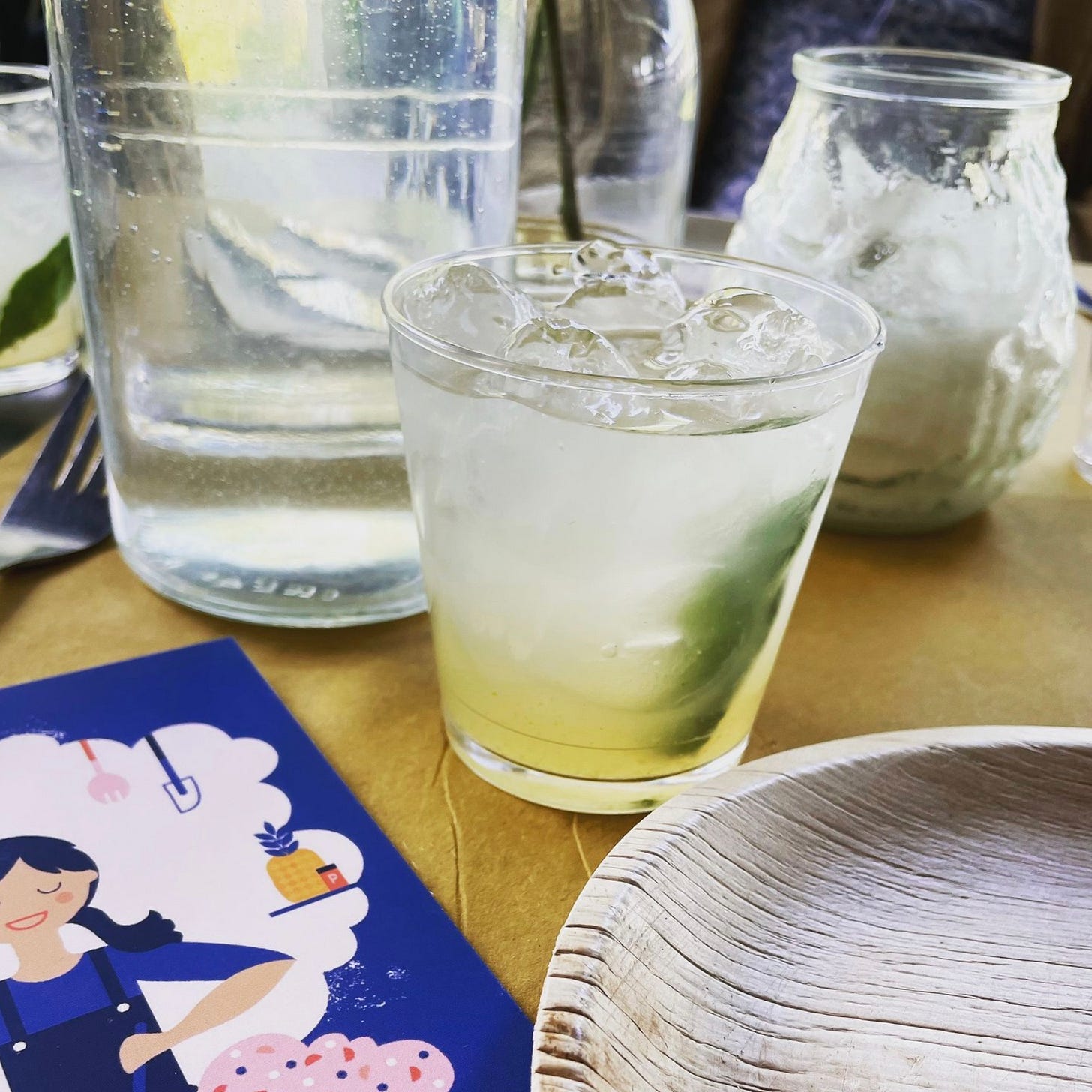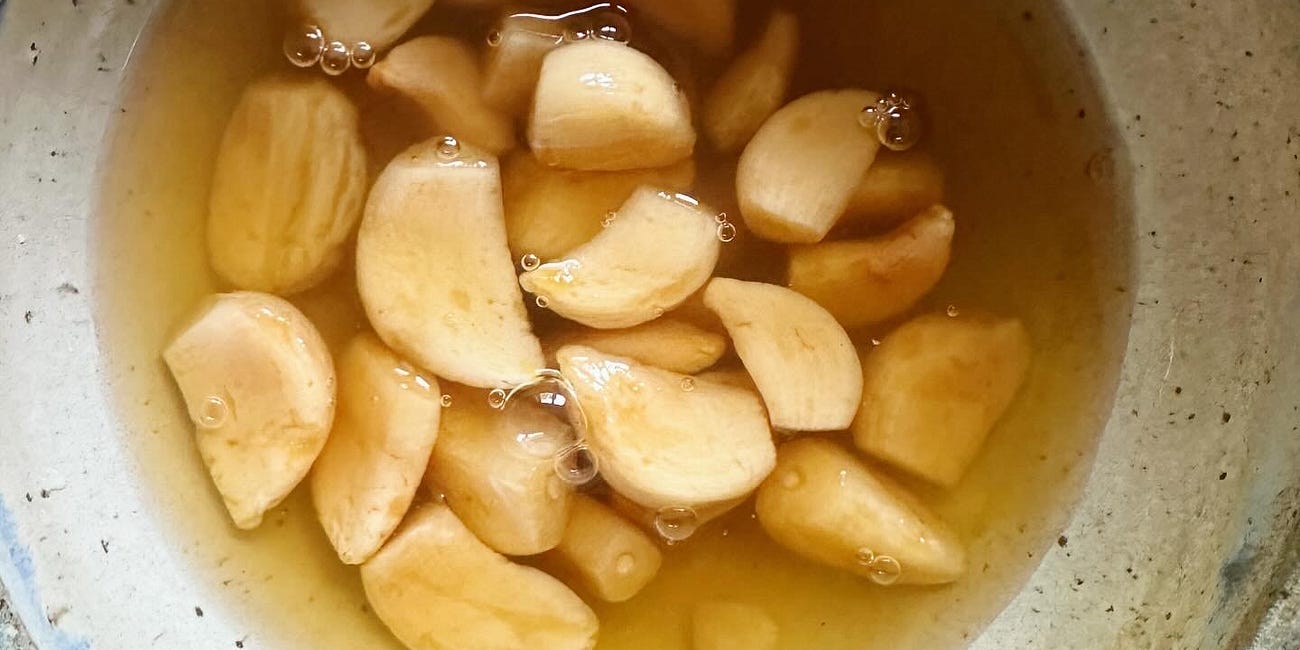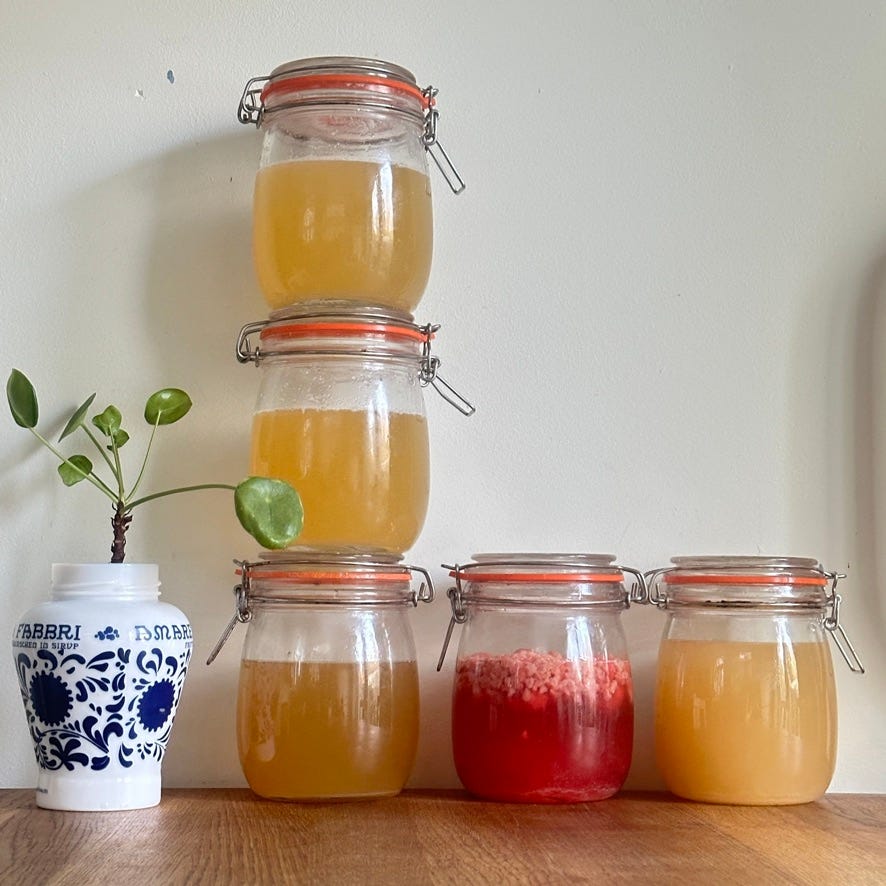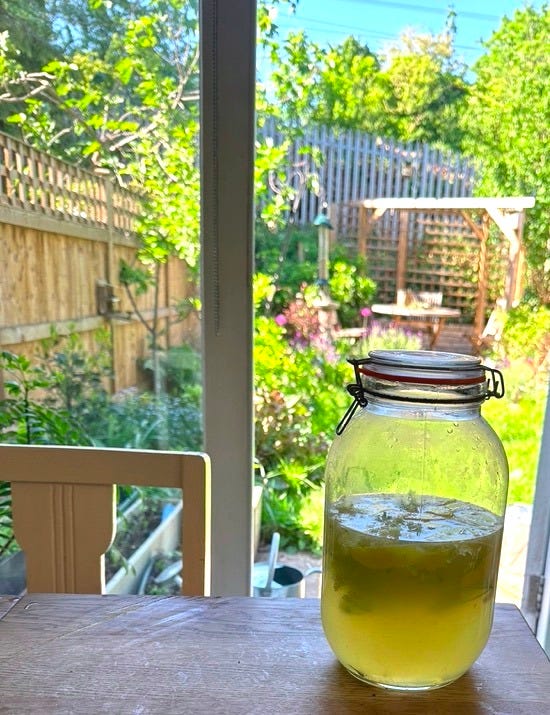In Good Taste #: 90 Elderflower Mead
A floral, honey-based booze; my guide to picking elderflowers; two different Bennetts
Well, hello there! How are you?
Good I hope.
(Not up for the chitchat? Completely get it. Click the email title to go to a web-based version then jump straight to the recipe or Cultural Fun.)
It’s fully elderflower season! I catered a delivery dinner party two weeks ago and could barely scrounge the handful of blossom necessary for salad garnish but now, everywhere I go I can see fragrant white froth in the trees.
It’s also - apparently - World Bee Day on the 20th. So I thought how better to celebrate with some seasonal mead: a gift from both the bees and the trees.
I made a little video to help you identify elderflowers.
For anyone still hesitant, I’ll be popping out for a mini-forage in Finsbury Park and up the Parkland walk at 11am on Saturday morning. We’ll meet at the Finsbury Park cafe and have a wander. I’ll show you my favourite spots, we’ll gather some flowers and have a chat about what to do with them. 30 minutes, tops. Then maybe get a coffee afterwards. Drop me a message if you want to come and subscribe to know about future lime blossom-picking jaunts.
My first precious haul of the year got pickled for that delivery salad - the garnish for a combination of cucumber, strawberries and goats cheese. I use the Natoora recipe from this post although scale it down considerably, using only 500ml of vinegar. You get an incredible, sweet, floral vinegar as well as the delicious pickled flowers.
But, now the elderflowers are more plentiful I’ve been able to gather a proper haul and have got my now-traditional “Champagne” underway. I shared the recipe two years ago in this post and know loads of people for whom making a couple of bottles is a summer tradition. Consider my heart gladdened.
This particular fizz is destined for the welcome cocktails at my Lizzy’s on the Green supper clubs in July. Here’s a little tipple from last year.
The full menu is as follows:
Elderflower “Champagne” cocktail
Kimchi devilled eggs
Carrot kraut fritters, coriander yogurt
Freshly-baked soda bread, cultured kefir butter, radishes
Ricotta & preserved lemon tortellini, herb butter, leeks, peas, pangrattato
Freshly-milled wholemeal beetroot ravioli, fennel, walnuts
Lamb meatballs/aubergine kofte cooked in fig leaves
Heritage tomato & pomegranate salad
Cherry noyaux baked Alaska
I would love to see you there.
Mead
Honey has always been important to humans. Before sugar became widespread it was mankind’s most concentrated form of sweetness and therefore highly prized.
A painting found in the Cuevas de la Araña in Spain showing someone climbing vines to collect honey is thought to be 8,000 years old. Another painting, 7,500 years old, in Castellote, portrays the use of a rope ladder. The existence of the paintings suggests that the gatherers were held in high esteem for the dangers they would endure to get hold of their prize.

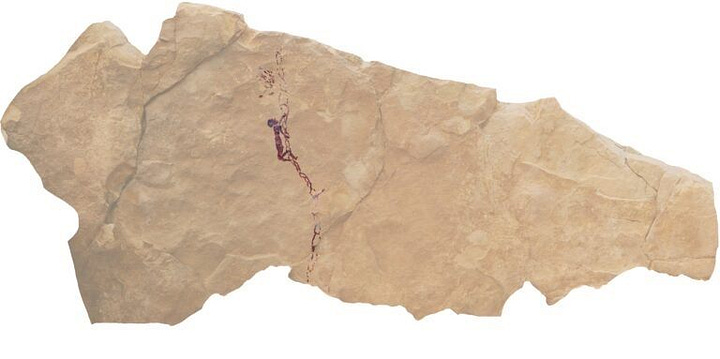
The earliest known depiction of beekeeping is from ancient Egypt, in reliefs at the Temple of the Sun at Abusir in Ancient Egypt dating to 2600 BC.
It’s generally agreed by archeologists and food historians that alcohol was probably the first deliberate fermentation done by humans. And it’s likely that the first alcohol was mead. Yeasts are naturally present in honey but it’s water content is usually 17%, too low for them to activate. Yet you only need to increase that water content to 19% to wake them up and get them going. It’s easy to imagine how honeycomb could have become wet with rain, producing something with such pleasant effects that more honey was deliberately dampened.
You don’t even have to add water: garlic cloves, berries or fresh herbs contain enough moisture to tip the balance and start things fermenting.
In Sandor Ellix Katz’s foundational text The Art of Fermentation he describes two fermented drinks:
“As I prepared to write this chapter my neighbour Jake showed up one evening with some of his week-old wine. He had dissolved sugar into water, to taste (without measuring), and added and added an array of chopped up ripe fruits fresh from a supermarket Dumpster, with no yeast except what was on the fruit. He stirred the mix frequently as it fermented in a bucket.
The wine was fresh, light, sweet, bubbly and already quite perceptibly alcoholic. A few days later I pulled out a bottle of six-year-old plum mead. The initial fermentation of the mead - six years back - was not so different from Jake's wine. In a ceramic crock, I had mixed raw honey with unheated water at a ratio of 4 parts water to 1 part honey. Then I added fresh whole small plums and stirred frequently over the course of about a week, during which time the mixture became vigorously bubbly. I tasted some then, but most of it I strained and transferred to a five-gallon carboy, air-locked, and left to ferment for about six months until the visible action stopped. I then racked it into another air-locked carboy, left it to ferment another six months, bottled it and aged it in the cellar.
The six-year-old mead was drier, less sweet and considerably stronger than Jake's week old wine but also required all those additional steps and all those years of passing time.”
As with all home brewing you can make mead as simply or as complicatedly and precisely as you like. it depends what effects you’re after and how instant you like your gratification.
For me, at least for where I am on my “fermentation journey” right now, I gravitate towards the low-tech and easily do-able. Things you can have a crack at on a whim and that don’t require specialist equipment - I don’t even have Katz’ carboys so my meads were all made in large jars then decanted into plastic bottles.
Today’s recipe is for an elderflower mead which is quite light: roughly one part honey to six parts water to mirror the sugar content of my “Champagne” recipe. But earlier in the year I experimented with meads made with 1:2, 1:3 and 1:4 ratios as well as with raspberries and using apple juice instead of water at a 1:4 ratio. The higher the concentration of honey, the longer they took to ferment. I drank the fruity meads quite young, after just a couple of weeks but, four months on, the others are still fermenting away, still sweet but getting gradually drier.
During alcoholic fermentation yeasts convert sugar into ethanol and carbon dioxide. Honey contains two types of sugar: glucose (which ferments quickly) and fructose (much slower). The initial bubbles you see over the first week will be the result of glucose. Then longer fermentation over the next few month will be fructose.,
You can make your mead plain or flavour it with whatever you like: fruits (fruit meads are called melomels), flowers or herbs (herbal meads are called metheglin and often considered to have medicinal properties).
The crucial thing is to use raw honey which contains plenty of yeasts. See if you can find a local producer. There’s a surprising number of them around. Otherwise anything that declares itself raw will do. When I ran out of local stuff I had good results with Odysea.
Recipe: Elderflower Mead
Makes approximately 1.5 litres
Ingredients
250g raw honey
1400ml water (filtered or otherwise dechlorinated)
2 lemons
10 heads elderflower, shaken to remove any bugs
Method
Dilute the honey with the water. Sterilise a large (2 lites or so) container with an airtight lid. You can do this by running it through a short, hot cycle on a dishwasher or putting it in a 100°C oven for twenty minutes. Let it cool before adding the honey and water and mixing well until the honey is completely dissolved.
Add the lemon and flowers. Zest one of the lemons using a vegetable peeler. Put the strips of zest in the container with the honey water. Squeeze both lemons and add the juice to the container too. Mix in the flowers.
Leave, stirring regularly, for a week. Once a day give the jar a shake or open it and stir vigorously with a long-handled spoon. After a few days you’ll notice bubbles on the surface and hear an audible fffttt of escaping gas when you open the container. This is a good sign. It means fermentation has begun.
Strain out the flowers and zest. After a week taste the mead. If it has a distinct elderflower taste, strain through a sieve (leaving behind the spent yeast “lees” in the bottom of the container) to remove the flowers and zest. If not, leave them for a few more days then taste again. Once strained, transfer to another vessel to continue fermenting. I like to use 2 litre Coke bottles, at least until gas production has slowed right down, as plastic has a bit of give in it and is less likely to explode than prettier glass…
Drink chilled or continue to ferment and age. It’s up to you. I am inclined to agree with Katz who says: “I have come to enjoy the smoothness that develops over years of aging. But for people first experimenting with fermentation I strongly recommend enjoying some green. You do not need to delay gratification for years. Once you do it a few times and get comfortable with the process, you can start making bigger batches and aging them.” If you want to continue aging, you will need a vessel with an airlock which you can get one from most home brewing suppliers.
Notes (If Ifs And Ands Were Pots And Pans…)
Elderflowers are best gathered on a sunny morning. Don’t pick them just after rain as they will lack both flavour and yeasts. After gathering, give them a good shake to get rid of any insects and trim off any large bits of stalk.
Cultural Fun
James and I went to see comic Scott Bennett do his show Blood Sugar Baby at the Soho Theatre. It’s the true story of Bennett’s daughter’s rare genetic illness but - as he was keen to point out - has a happy ending and is packed with plenty of gags.
We’d not seen Bennett before and he’s a pretty old school comic, a circuit man through and through, clearly slightly uncomfortable with the level of personal disclosure necessary for this kind of show - a typical story-based “Edinburgh show” - to succeed.
The first half suffered from his unwillingness to give us a bit of medical nitty gritty or explore the trauma of spending five months in hospital-based limbo. But once he opened up a bit more things got going and it was a well constructed show. Also, one side effect of the medication Bennett’s daughter was given was that it made her very hairy and the idea of a hairy baby is inherently very funny.
(The version of London Bridge in Michael Rosen’s Hairy Tales and Nursery Crimes still makes me laugh whenever I think about it:
London bridge is falling down, falling down, falling down
London bridge is falling down
My hairy baby)
In more Bennett-based cultural news, I read The Other Bennet Sister by Janice Hadlow and enjoyed it. A Christmas gift from my mother, it spent several months in the teetering pile on my bedside table before I got round to cracking the covers, but I raced through it once I did.
It focuses on Mary, the bookish middle sister in Pride and Prejudice. Austen doesn’t give her much of a role except as a priggish comic foil and onlooker to her sister’s romantic exploits. Here she is our protagonist and a very sympathetic one. Hadlow gives us plenty of vivid period detail which I enjoyed for its own sake and also for the light it threw on Austen’s wider world. A return to the originals is due…
A future recommendation: I see Kieran Hodgson has a new show. Voice of America is coming to the Soho Theatre and the Pleasance during the Edinburgh Fringe and will doubtless be on tour after that. His shows are always very clever and very funny and he’s a virtuosic performer, great at accents, so I can’t wait to see what his American is like.
Bye! See you next week!
In the meantime, if you felt like sharing In Good Taste with friends or family who might enjoy it, you can do so with the button below.
Or upgrade to paid to support the work I do. Either would mean a lot to me. Thanks so much.
In Good Taste is a Sycamore Smyth newsletter by me, Clare Heal.
It’s free to subscribe and new issues will appear in your inbox every Thursday.
You can also access it via the Substack website or app where each issue remains free or a month after publication but older posts and archive access are for paid subscribers only. If you can afford it, do consider upgrading to paid to support my work - those vegetables won’t ferment themselves...
I also occasionally include affiliate links to Bookshop.org and will earn a small commission on anything purchased via a clickthrough.
You can also find me on Instagram or visit my website to find information about my catering work, cookery lessons and upcoming events.






